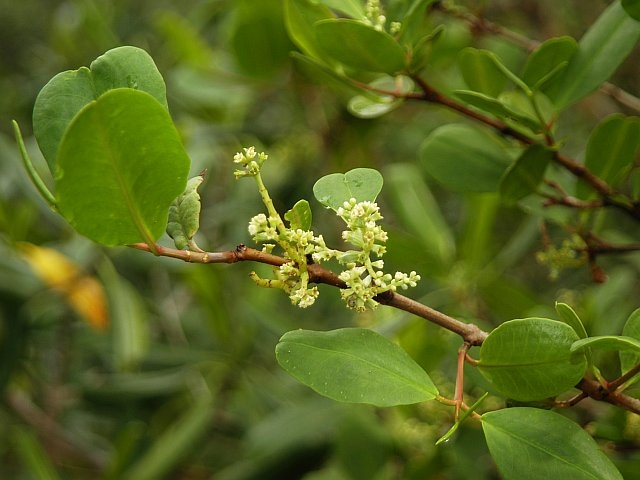White Mangrove
(Laguncularia racemosa)
White Mangrove (Laguncularia racemosa)
/
/

Ulf Mehlig
CC BY-SA 2.5
Image By:
Ulf Mehlig
Recorded By:
Copyright:
CC BY-SA 2.5
Copyright Notice:
Photo by: Ulf Mehlig | License Type: CC BY-SA 2.5 | License URL: https://creativecommons.org/licenses/by-sa/2.5 | Uploader: Umehlig | Publisher: Wikimedia Commons | Title: Laguncularia_racemosa.jpg | Notes: |



















































Estimated Native Range
Summary
Laguncularia racemosa, commonly known as White Mangrove, is an evergreen tree or shrub native to coastal salt marshes and mangrove swamps in the Tropical Americas, the Caribbean, and West Africa. This species typically grows to 12–18 m (39–59 ft) tall and is well adapted to saline environments. The White Mangrove has a distinctive appearance with its thick, leathery leaves that are silver-green in color and possess two glands at the base of the leaf blade. The small, white, bell-shaped flowers are mostly bisexual, measuring about 5 mm (0.20 in) long, and bloom in the summer. They are followed by reddish-brown drupes that are about 12–20 mm (0.47–0.79 in) long, with longitudinal ridges. The fruit contains a single seed that is sometimes viviparous, meaning it can germinate while still attached to the parent tree.
White Mangrove is valued for its ability to stabilize shorelines and provide habitat for wildlife. It is often used in coastal restoration projects and can be a key species in mangrove reforestation efforts. The tree is also known for its resilience to flooding and high salinity, making it an excellent choice for challenging coastal environments. In cultivation, it requires full sun and can tolerate a range of water conditions, including high amounts of water, and is adaptable to soils with varying drainage speeds. While it is not typically grown for ornamental purposes, its ecological importance cannot be overstated.CC BY-SA 4.0
White Mangrove is valued for its ability to stabilize shorelines and provide habitat for wildlife. It is often used in coastal restoration projects and can be a key species in mangrove reforestation efforts. The tree is also known for its resilience to flooding and high salinity, making it an excellent choice for challenging coastal environments. In cultivation, it requires full sun and can tolerate a range of water conditions, including high amounts of water, and is adaptable to soils with varying drainage speeds. While it is not typically grown for ornamental purposes, its ecological importance cannot be overstated.CC BY-SA 4.0
Plant Description
- Plant Type: Tree, Shrub
- Height: 20-50 feet
- Width: 15-20 feet
- Growth Rate: Rapid
- Flower Color: N/A
- Flowering Season: Spring
- Leaf Retention: Evergreen
Growth Requirements
- Sun: Full Sun
- Water: High
- Drainage: Fast, Medium, Slow
Common Uses
Erosion Control, Low Maintenance, Water Garden
Natural Habitat
Coastal salt marshes and mangrove swamps in the Tropical Americas, the Caribbean, and West Africa
Other Names
Common Names: White Buttonwood, Mangue Branco, Tinteira, Mangle Blanco, Mangle Bobo
Scientific Names: , Laguncularia racemosa, Conocarpus racemosa, Laguncularia obovata, Laguncularia racemosa f. longifolia, Horau racemosus, Laguncuaria racemosa, Laguncularia martii, Rhizaeris alba, Schousboea commutata,
GBIF Accepted Name: Laguncularia racemosa (L.) C.F.Gaertn.